Individual Taxpayer Case Study: Taxation Law Analysis and Strategies
VerifiedAdded on 2022/08/29
|10
|2829
|14
Case Study
AI Summary
This document presents a comprehensive analysis of an individual taxpayer's tax obligations, addressing various income sources, deductions, and tax offsets. The case study examines income from employment, business operations, and rental property, detailing the application of relevant tax laws such as the Income Tax Assessment Act 1936 and 1997. The analysis covers topics including taxable income, fringe benefits, allowable deductions for business expenses, and rental property income, as well as the application of cash basis accounting. The solution also explores the implications of insurance compensation, drawings, and depreciation, alongside the eligibility for dependent tax offsets. It provides a detailed breakdown of each component, citing relevant sections of the tax legislation and case law to support the conclusions. The document serves as a valuable resource for understanding the complexities of individual tax assessments and the practical application of tax law principles.
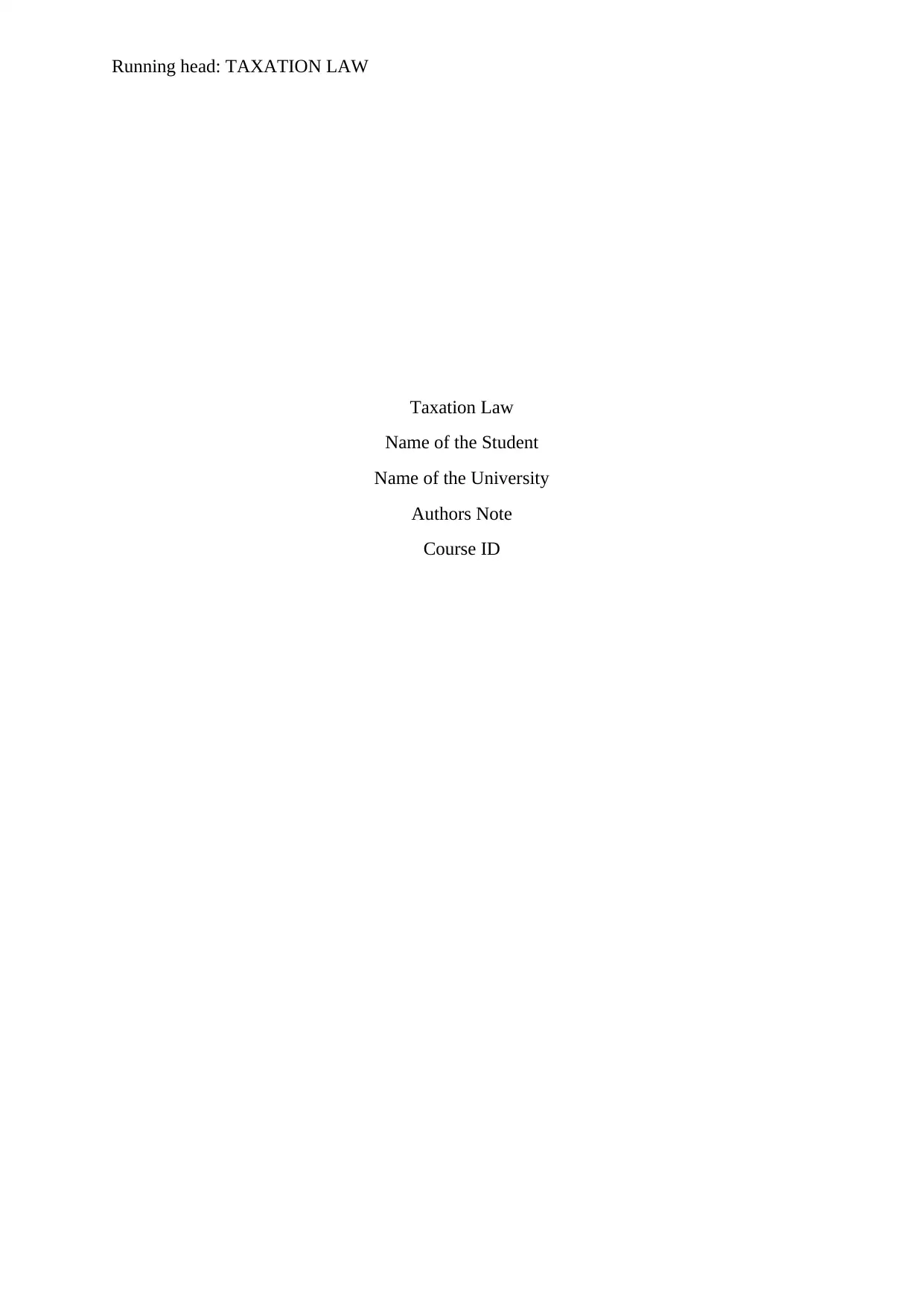
Running head: TAXATION LAW
Taxation Law
Name of the Student
Name of the University
Authors Note
Course ID
Taxation Law
Name of the Student
Name of the University
Authors Note
Course ID
Paraphrase This Document
Need a fresh take? Get an instant paraphrase of this document with our AI Paraphraser
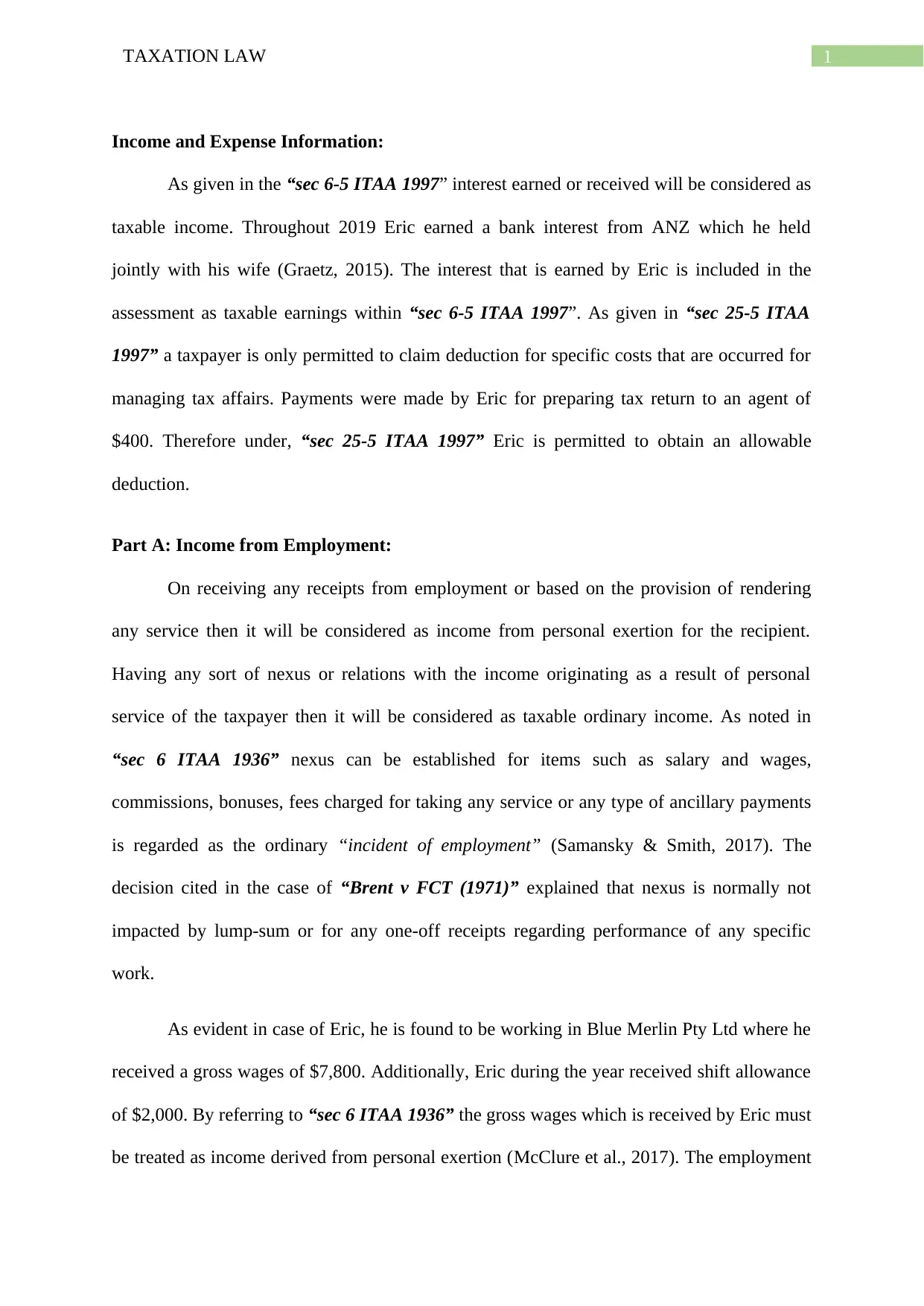
1TAXATION LAW
Income and Expense Information:
As given in the “sec 6-5 ITAA 1997” interest earned or received will be considered as
taxable income. Throughout 2019 Eric earned a bank interest from ANZ which he held
jointly with his wife (Graetz, 2015). The interest that is earned by Eric is included in the
assessment as taxable earnings within “sec 6-5 ITAA 1997”. As given in “sec 25-5 ITAA
1997” a taxpayer is only permitted to claim deduction for specific costs that are occurred for
managing tax affairs. Payments were made by Eric for preparing tax return to an agent of
$400. Therefore under, “sec 25-5 ITAA 1997” Eric is permitted to obtain an allowable
deduction.
Part A: Income from Employment:
On receiving any receipts from employment or based on the provision of rendering
any service then it will be considered as income from personal exertion for the recipient.
Having any sort of nexus or relations with the income originating as a result of personal
service of the taxpayer then it will be considered as taxable ordinary income. As noted in
“sec 6 ITAA 1936” nexus can be established for items such as salary and wages,
commissions, bonuses, fees charged for taking any service or any type of ancillary payments
is regarded as the ordinary “incident of employment” (Samansky & Smith, 2017). The
decision cited in the case of “Brent v FCT (1971)” explained that nexus is normally not
impacted by lump-sum or for any one-off receipts regarding performance of any specific
work.
As evident in case of Eric, he is found to be working in Blue Merlin Pty Ltd where he
received a gross wages of $7,800. Additionally, Eric during the year received shift allowance
of $2,000. By referring to “sec 6 ITAA 1936” the gross wages which is received by Eric must
be treated as income derived from personal exertion (McClure et al., 2017). The employment
Income and Expense Information:
As given in the “sec 6-5 ITAA 1997” interest earned or received will be considered as
taxable income. Throughout 2019 Eric earned a bank interest from ANZ which he held
jointly with his wife (Graetz, 2015). The interest that is earned by Eric is included in the
assessment as taxable earnings within “sec 6-5 ITAA 1997”. As given in “sec 25-5 ITAA
1997” a taxpayer is only permitted to claim deduction for specific costs that are occurred for
managing tax affairs. Payments were made by Eric for preparing tax return to an agent of
$400. Therefore under, “sec 25-5 ITAA 1997” Eric is permitted to obtain an allowable
deduction.
Part A: Income from Employment:
On receiving any receipts from employment or based on the provision of rendering
any service then it will be considered as income from personal exertion for the recipient.
Having any sort of nexus or relations with the income originating as a result of personal
service of the taxpayer then it will be considered as taxable ordinary income. As noted in
“sec 6 ITAA 1936” nexus can be established for items such as salary and wages,
commissions, bonuses, fees charged for taking any service or any type of ancillary payments
is regarded as the ordinary “incident of employment” (Samansky & Smith, 2017). The
decision cited in the case of “Brent v FCT (1971)” explained that nexus is normally not
impacted by lump-sum or for any one-off receipts regarding performance of any specific
work.
As evident in case of Eric, he is found to be working in Blue Merlin Pty Ltd where he
received a gross wages of $7,800. Additionally, Eric during the year received shift allowance
of $2,000. By referring to “sec 6 ITAA 1936” the gross wages which is received by Eric must
be treated as income derived from personal exertion (McClure et al., 2017). The employment

2TAXATION LAW
wages that is earned is included in the tax return of Eric as income under “sec 6-5 ITAA
1997”. Referring to Brent v FCT (1971)” the sum will be held as payment in Eric hands
since it holds necessary relation with the receipts and the income producing acts.
More importantly under the “sec 15-2 of the ITAA 1997” allowances that an
employee receives cannot be viewed as taxable fringe benefit (Fullarton, 2017). Instead it is
considered as taxable earnings for employee. The shift allowance received by Eric will be
taxable as statutory earnings for Eric within “sec 15-2 ITAA 1997”.
During the year the employer of Eric provided him with car. According to the
“division 2 of the FBTAA 1986” car fringe benefit happens when the car is given to
employee by employer for their private use. Under the “division 2 of the FBTAA 1986” the
car received by Eric will be considered as chargeable fringe benefit. Accordingly under the
“sec 23L ITAA 1936”, there is a direct relation among the employment of Eric with the
benefit that is received by him. Citing the case of “FCT v J&G Knowles”, the car received is
carrying relation with the benefit and employment of Eric (McLaren, 2019). The Car should
be treated as fringe benefit whereas for the employer, it will be required to pay fringe benefit
tax associated to the value of benefit rendered.
According to the “sec 8-1 (1), ITAA 1997” an individual taxpayer is allowed to claim
deduction relating to any outgoing or loss from the taxable earnings till the extent that the
outgoing has occurred in generating assessable income or carrying any type of business
activities (Raftery, 2019). In the present situation Eric has reported that he incurred expenses
on telephone and stationary for work purpose. With regard to “sec 8-1 (1)”, Eric is allowed to
claim a tax deduction since the outgoing were incurred by in producing assessable income.
wages that is earned is included in the tax return of Eric as income under “sec 6-5 ITAA
1997”. Referring to Brent v FCT (1971)” the sum will be held as payment in Eric hands
since it holds necessary relation with the receipts and the income producing acts.
More importantly under the “sec 15-2 of the ITAA 1997” allowances that an
employee receives cannot be viewed as taxable fringe benefit (Fullarton, 2017). Instead it is
considered as taxable earnings for employee. The shift allowance received by Eric will be
taxable as statutory earnings for Eric within “sec 15-2 ITAA 1997”.
During the year the employer of Eric provided him with car. According to the
“division 2 of the FBTAA 1986” car fringe benefit happens when the car is given to
employee by employer for their private use. Under the “division 2 of the FBTAA 1986” the
car received by Eric will be considered as chargeable fringe benefit. Accordingly under the
“sec 23L ITAA 1936”, there is a direct relation among the employment of Eric with the
benefit that is received by him. Citing the case of “FCT v J&G Knowles”, the car received is
carrying relation with the benefit and employment of Eric (McLaren, 2019). The Car should
be treated as fringe benefit whereas for the employer, it will be required to pay fringe benefit
tax associated to the value of benefit rendered.
According to the “sec 8-1 (1), ITAA 1997” an individual taxpayer is allowed to claim
deduction relating to any outgoing or loss from the taxable earnings till the extent that the
outgoing has occurred in generating assessable income or carrying any type of business
activities (Raftery, 2019). In the present situation Eric has reported that he incurred expenses
on telephone and stationary for work purpose. With regard to “sec 8-1 (1)”, Eric is allowed to
claim a tax deduction since the outgoing were incurred by in producing assessable income.
⊘ This is a preview!⊘
Do you want full access?
Subscribe today to unlock all pages.

Trusted by 1+ million students worldwide
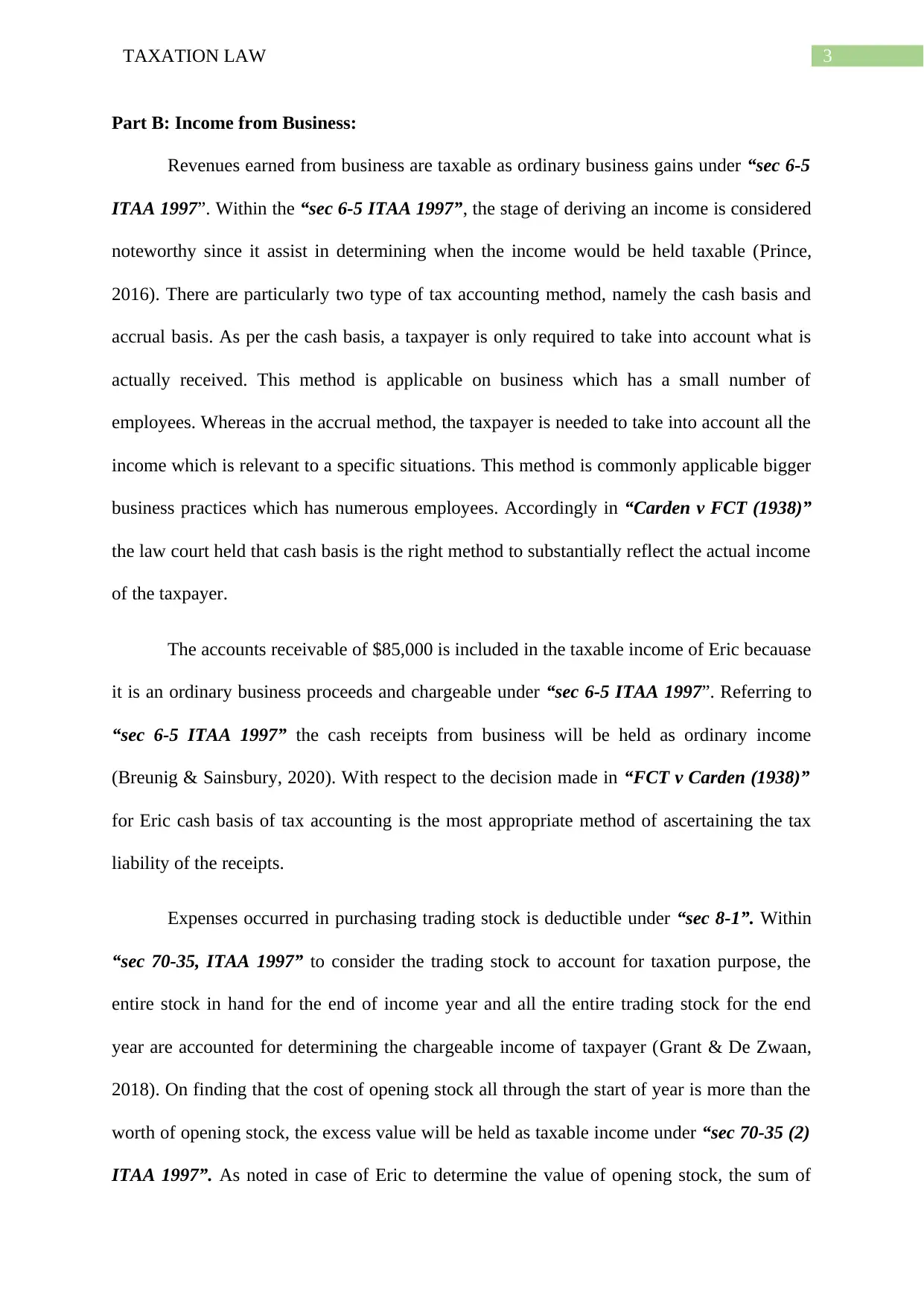
3TAXATION LAW
Part B: Income from Business:
Revenues earned from business are taxable as ordinary business gains under “sec 6-5
ITAA 1997”. Within the “sec 6-5 ITAA 1997”, the stage of deriving an income is considered
noteworthy since it assist in determining when the income would be held taxable (Prince,
2016). There are particularly two type of tax accounting method, namely the cash basis and
accrual basis. As per the cash basis, a taxpayer is only required to take into account what is
actually received. This method is applicable on business which has a small number of
employees. Whereas in the accrual method, the taxpayer is needed to take into account all the
income which is relevant to a specific situations. This method is commonly applicable bigger
business practices which has numerous employees. Accordingly in “Carden v FCT (1938)”
the law court held that cash basis is the right method to substantially reflect the actual income
of the taxpayer.
The accounts receivable of $85,000 is included in the taxable income of Eric becauase
it is an ordinary business proceeds and chargeable under “sec 6-5 ITAA 1997”. Referring to
“sec 6-5 ITAA 1997” the cash receipts from business will be held as ordinary income
(Breunig & Sainsbury, 2020). With respect to the decision made in “FCT v Carden (1938)”
for Eric cash basis of tax accounting is the most appropriate method of ascertaining the tax
liability of the receipts.
Expenses occurred in purchasing trading stock is deductible under “sec 8-1”. Within
“sec 70-35, ITAA 1997” to consider the trading stock to account for taxation purpose, the
entire stock in hand for the end of income year and all the entire trading stock for the end
year are accounted for determining the chargeable income of taxpayer (Grant & De Zwaan,
2018). On finding that the cost of opening stock all through the start of year is more than the
worth of opening stock, the excess value will be held as taxable income under “sec 70-35 (2)
ITAA 1997”. As noted in case of Eric to determine the value of opening stock, the sum of
Part B: Income from Business:
Revenues earned from business are taxable as ordinary business gains under “sec 6-5
ITAA 1997”. Within the “sec 6-5 ITAA 1997”, the stage of deriving an income is considered
noteworthy since it assist in determining when the income would be held taxable (Prince,
2016). There are particularly two type of tax accounting method, namely the cash basis and
accrual basis. As per the cash basis, a taxpayer is only required to take into account what is
actually received. This method is applicable on business which has a small number of
employees. Whereas in the accrual method, the taxpayer is needed to take into account all the
income which is relevant to a specific situations. This method is commonly applicable bigger
business practices which has numerous employees. Accordingly in “Carden v FCT (1938)”
the law court held that cash basis is the right method to substantially reflect the actual income
of the taxpayer.
The accounts receivable of $85,000 is included in the taxable income of Eric becauase
it is an ordinary business proceeds and chargeable under “sec 6-5 ITAA 1997”. Referring to
“sec 6-5 ITAA 1997” the cash receipts from business will be held as ordinary income
(Breunig & Sainsbury, 2020). With respect to the decision made in “FCT v Carden (1938)”
for Eric cash basis of tax accounting is the most appropriate method of ascertaining the tax
liability of the receipts.
Expenses occurred in purchasing trading stock is deductible under “sec 8-1”. Within
“sec 70-35, ITAA 1997” to consider the trading stock to account for taxation purpose, the
entire stock in hand for the end of income year and all the entire trading stock for the end
year are accounted for determining the chargeable income of taxpayer (Grant & De Zwaan,
2018). On finding that the cost of opening stock all through the start of year is more than the
worth of opening stock, the excess value will be held as taxable income under “sec 70-35 (2)
ITAA 1997”. As noted in case of Eric to determine the value of opening stock, the sum of
Paraphrase This Document
Need a fresh take? Get an instant paraphrase of this document with our AI Paraphraser
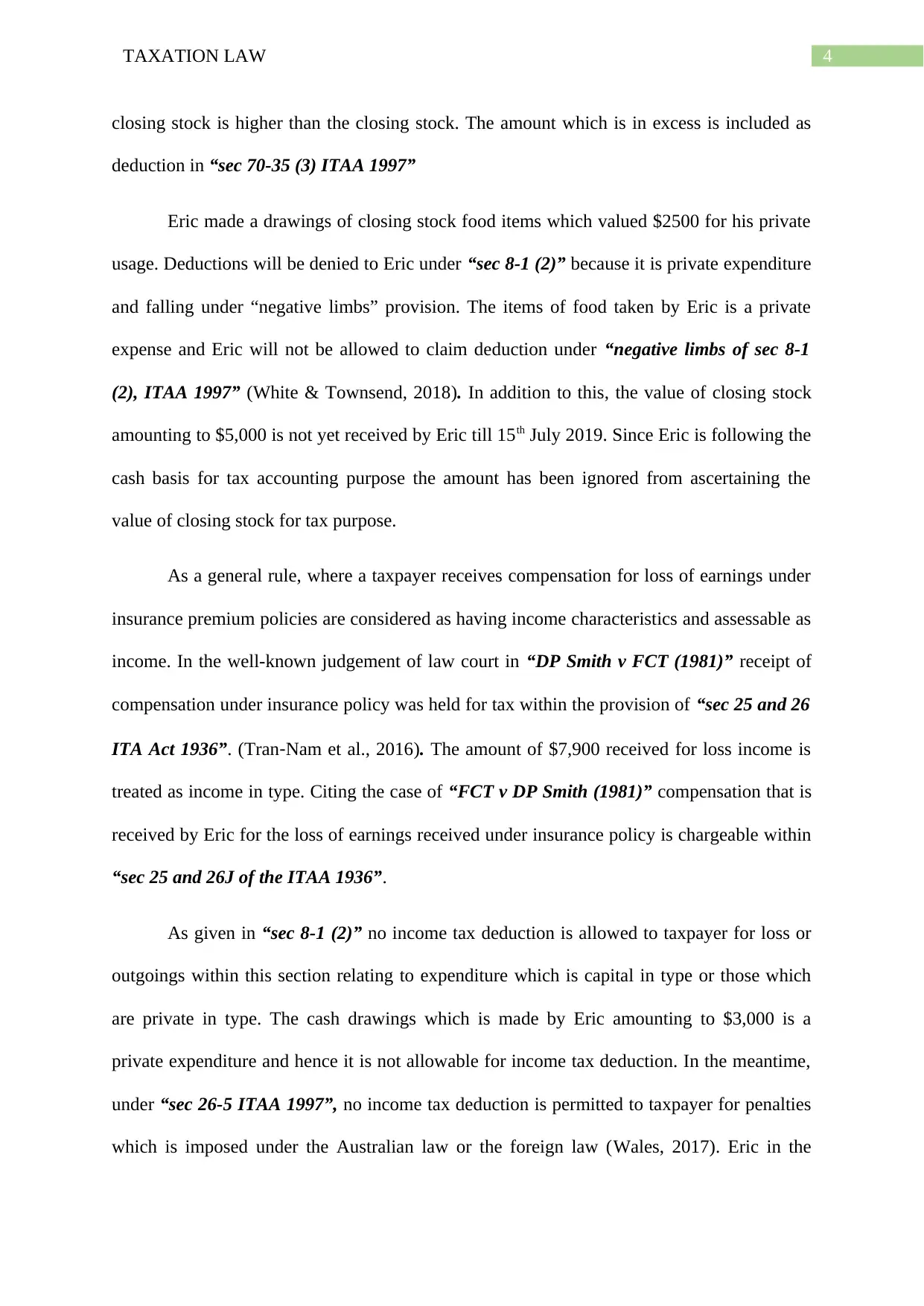
4TAXATION LAW
closing stock is higher than the closing stock. The amount which is in excess is included as
deduction in “sec 70-35 (3) ITAA 1997”
Eric made a drawings of closing stock food items which valued $2500 for his private
usage. Deductions will be denied to Eric under “sec 8-1 (2)” because it is private expenditure
and falling under “negative limbs” provision. The items of food taken by Eric is a private
expense and Eric will not be allowed to claim deduction under “negative limbs of sec 8-1
(2), ITAA 1997” (White & Townsend, 2018). In addition to this, the value of closing stock
amounting to $5,000 is not yet received by Eric till 15th July 2019. Since Eric is following the
cash basis for tax accounting purpose the amount has been ignored from ascertaining the
value of closing stock for tax purpose.
As a general rule, where a taxpayer receives compensation for loss of earnings under
insurance premium policies are considered as having income characteristics and assessable as
income. In the well-known judgement of law court in “DP Smith v FCT (1981)” receipt of
compensation under insurance policy was held for tax within the provision of “sec 25 and 26
ITA Act 1936”. (Tran‐Nam et al., 2016). The amount of $7,900 received for loss income is
treated as income in type. Citing the case of “FCT v DP Smith (1981)” compensation that is
received by Eric for the loss of earnings received under insurance policy is chargeable within
“sec 25 and 26J of the ITAA 1936”.
As given in “sec 8-1 (2)” no income tax deduction is allowed to taxpayer for loss or
outgoings within this section relating to expenditure which is capital in type or those which
are private in type. The cash drawings which is made by Eric amounting to $3,000 is a
private expenditure and hence it is not allowable for income tax deduction. In the meantime,
under “sec 26-5 ITAA 1997”, no income tax deduction is permitted to taxpayer for penalties
which is imposed under the Australian law or the foreign law (Wales, 2017). Eric in the
closing stock is higher than the closing stock. The amount which is in excess is included as
deduction in “sec 70-35 (3) ITAA 1997”
Eric made a drawings of closing stock food items which valued $2500 for his private
usage. Deductions will be denied to Eric under “sec 8-1 (2)” because it is private expenditure
and falling under “negative limbs” provision. The items of food taken by Eric is a private
expense and Eric will not be allowed to claim deduction under “negative limbs of sec 8-1
(2), ITAA 1997” (White & Townsend, 2018). In addition to this, the value of closing stock
amounting to $5,000 is not yet received by Eric till 15th July 2019. Since Eric is following the
cash basis for tax accounting purpose the amount has been ignored from ascertaining the
value of closing stock for tax purpose.
As a general rule, where a taxpayer receives compensation for loss of earnings under
insurance premium policies are considered as having income characteristics and assessable as
income. In the well-known judgement of law court in “DP Smith v FCT (1981)” receipt of
compensation under insurance policy was held for tax within the provision of “sec 25 and 26
ITA Act 1936”. (Tran‐Nam et al., 2016). The amount of $7,900 received for loss income is
treated as income in type. Citing the case of “FCT v DP Smith (1981)” compensation that is
received by Eric for the loss of earnings received under insurance policy is chargeable within
“sec 25 and 26J of the ITAA 1936”.
As given in “sec 8-1 (2)” no income tax deduction is allowed to taxpayer for loss or
outgoings within this section relating to expenditure which is capital in type or those which
are private in type. The cash drawings which is made by Eric amounting to $3,000 is a
private expenditure and hence it is not allowable for income tax deduction. In the meantime,
under “sec 26-5 ITAA 1997”, no income tax deduction is permitted to taxpayer for penalties
which is imposed under the Australian law or the foreign law (Wales, 2017). Eric in the
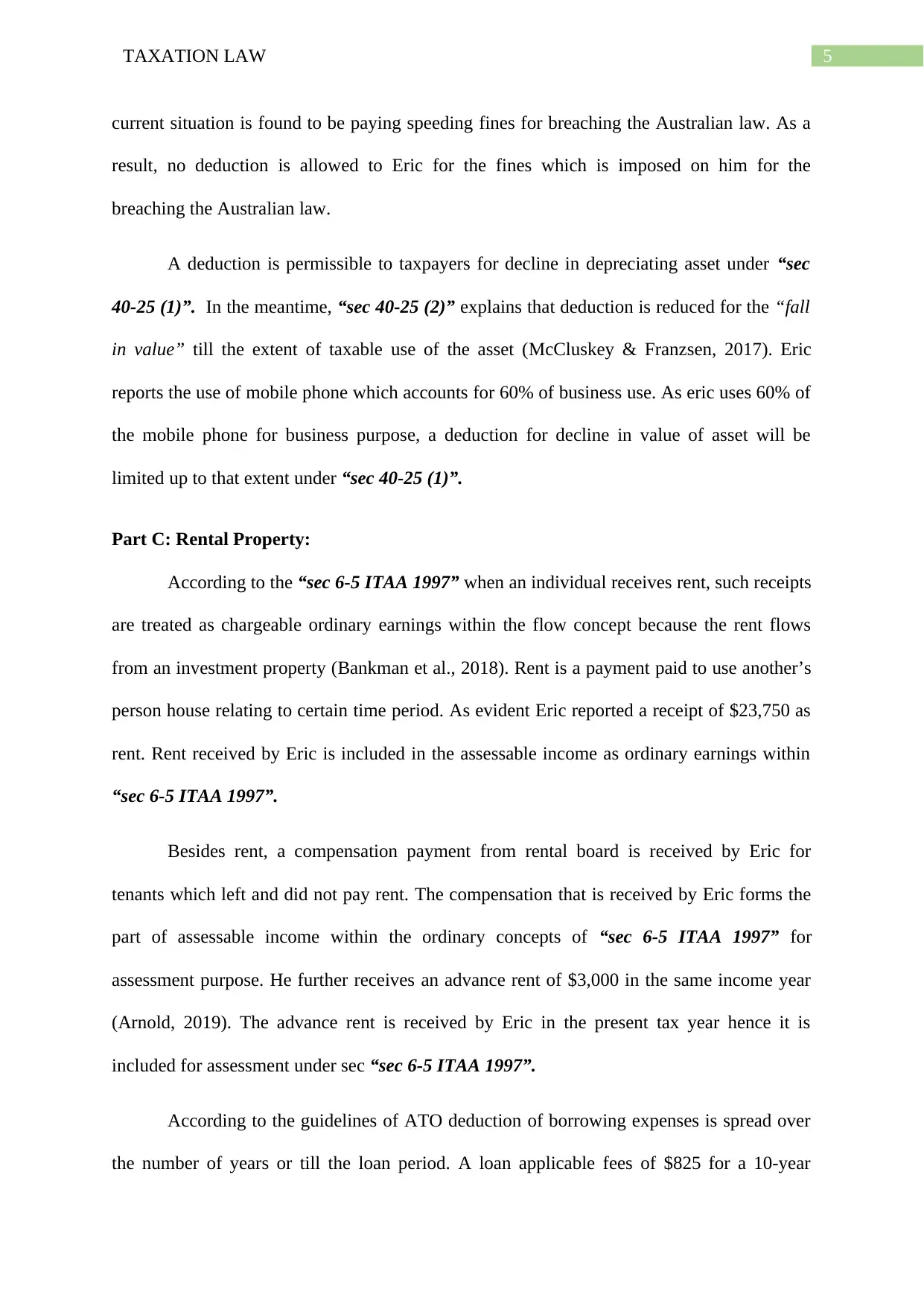
5TAXATION LAW
current situation is found to be paying speeding fines for breaching the Australian law. As a
result, no deduction is allowed to Eric for the fines which is imposed on him for the
breaching the Australian law.
A deduction is permissible to taxpayers for decline in depreciating asset under “sec
40-25 (1)”. In the meantime, “sec 40-25 (2)” explains that deduction is reduced for the “fall
in value” till the extent of taxable use of the asset (McCluskey & Franzsen, 2017). Eric
reports the use of mobile phone which accounts for 60% of business use. As eric uses 60% of
the mobile phone for business purpose, a deduction for decline in value of asset will be
limited up to that extent under “sec 40-25 (1)”.
Part C: Rental Property:
According to the “sec 6-5 ITAA 1997” when an individual receives rent, such receipts
are treated as chargeable ordinary earnings within the flow concept because the rent flows
from an investment property (Bankman et al., 2018). Rent is a payment paid to use another’s
person house relating to certain time period. As evident Eric reported a receipt of $23,750 as
rent. Rent received by Eric is included in the assessable income as ordinary earnings within
“sec 6-5 ITAA 1997”.
Besides rent, a compensation payment from rental board is received by Eric for
tenants which left and did not pay rent. The compensation that is received by Eric forms the
part of assessable income within the ordinary concepts of “sec 6-5 ITAA 1997” for
assessment purpose. He further receives an advance rent of $3,000 in the same income year
(Arnold, 2019). The advance rent is received by Eric in the present tax year hence it is
included for assessment under sec “sec 6-5 ITAA 1997”.
According to the guidelines of ATO deduction of borrowing expenses is spread over
the number of years or till the loan period. A loan applicable fees of $825 for a 10-year
current situation is found to be paying speeding fines for breaching the Australian law. As a
result, no deduction is allowed to Eric for the fines which is imposed on him for the
breaching the Australian law.
A deduction is permissible to taxpayers for decline in depreciating asset under “sec
40-25 (1)”. In the meantime, “sec 40-25 (2)” explains that deduction is reduced for the “fall
in value” till the extent of taxable use of the asset (McCluskey & Franzsen, 2017). Eric
reports the use of mobile phone which accounts for 60% of business use. As eric uses 60% of
the mobile phone for business purpose, a deduction for decline in value of asset will be
limited up to that extent under “sec 40-25 (1)”.
Part C: Rental Property:
According to the “sec 6-5 ITAA 1997” when an individual receives rent, such receipts
are treated as chargeable ordinary earnings within the flow concept because the rent flows
from an investment property (Bankman et al., 2018). Rent is a payment paid to use another’s
person house relating to certain time period. As evident Eric reported a receipt of $23,750 as
rent. Rent received by Eric is included in the assessable income as ordinary earnings within
“sec 6-5 ITAA 1997”.
Besides rent, a compensation payment from rental board is received by Eric for
tenants which left and did not pay rent. The compensation that is received by Eric forms the
part of assessable income within the ordinary concepts of “sec 6-5 ITAA 1997” for
assessment purpose. He further receives an advance rent of $3,000 in the same income year
(Arnold, 2019). The advance rent is received by Eric in the present tax year hence it is
included for assessment under sec “sec 6-5 ITAA 1997”.
According to the guidelines of ATO deduction of borrowing expenses is spread over
the number of years or till the loan period. A loan applicable fees of $825 for a 10-year
⊘ This is a preview!⊘
Do you want full access?
Subscribe today to unlock all pages.

Trusted by 1+ million students worldwide

6TAXATION LAW
mortgage has been occurred by Eric. Eric is advised to claim deduction of the same till the
span of 10 years for loan mortgage. As per the “sec 25-10 ITAA 1997” where a taxpayer
incurs expenses on initial repair soon after purchasing the property to remedy the defects that
is present while acquiring the property is held as initial repair and no deduction is permitted
in such case (Fry, 2017). Eric incurs expenses on painting the outside walls of the house. The
expense has been classified as initial repair and no deduction is permitted to Eric under “sec
25-10 (3)”. In the meantime, under “sec 8-1 ITAA 1997” Eric is allowed to claim deduction
for rental expenditure that is occurred by him from the day when the property was let out.
Dependent tax offset (valid and invalid carer tax offset):
The ATO says that a person is entitled to get invalid and invalid carer tax offset for a
person that maintains the following;
a. Their spouse, that is an invalid or those that cares for their invalid
b. The spouse or the parent of taxpayer’s spouse that lives in Australia and he or she is
invalid or cares for the invalid.
As per the ATO, the carer should; a
a. Gets a carer allowance under “Social Security Act 1991” for the care they give to a
person or;
b. They are completely involved in providing care to person that is receiving disability
support pension within the “Social Security Act 1991”.
Accordingly in case of Eric it is noticed that he is taking care of his wife Linda that
has lost vision in her left eye 9 months before because of car accident. A disability support
pension is received by Eric that amounts to $9,200. Eric is eligible for getting an invalid and
invalid carer tax offset for his wife because she receives a disability support pension within
“Social Security Act 1991”. Hence, an invalid tax offset is allowed to Eric.
mortgage has been occurred by Eric. Eric is advised to claim deduction of the same till the
span of 10 years for loan mortgage. As per the “sec 25-10 ITAA 1997” where a taxpayer
incurs expenses on initial repair soon after purchasing the property to remedy the defects that
is present while acquiring the property is held as initial repair and no deduction is permitted
in such case (Fry, 2017). Eric incurs expenses on painting the outside walls of the house. The
expense has been classified as initial repair and no deduction is permitted to Eric under “sec
25-10 (3)”. In the meantime, under “sec 8-1 ITAA 1997” Eric is allowed to claim deduction
for rental expenditure that is occurred by him from the day when the property was let out.
Dependent tax offset (valid and invalid carer tax offset):
The ATO says that a person is entitled to get invalid and invalid carer tax offset for a
person that maintains the following;
a. Their spouse, that is an invalid or those that cares for their invalid
b. The spouse or the parent of taxpayer’s spouse that lives in Australia and he or she is
invalid or cares for the invalid.
As per the ATO, the carer should; a
a. Gets a carer allowance under “Social Security Act 1991” for the care they give to a
person or;
b. They are completely involved in providing care to person that is receiving disability
support pension within the “Social Security Act 1991”.
Accordingly in case of Eric it is noticed that he is taking care of his wife Linda that
has lost vision in her left eye 9 months before because of car accident. A disability support
pension is received by Eric that amounts to $9,200. Eric is eligible for getting an invalid and
invalid carer tax offset for his wife because she receives a disability support pension within
“Social Security Act 1991”. Hence, an invalid tax offset is allowed to Eric.
Paraphrase This Document
Need a fresh take? Get an instant paraphrase of this document with our AI Paraphraser
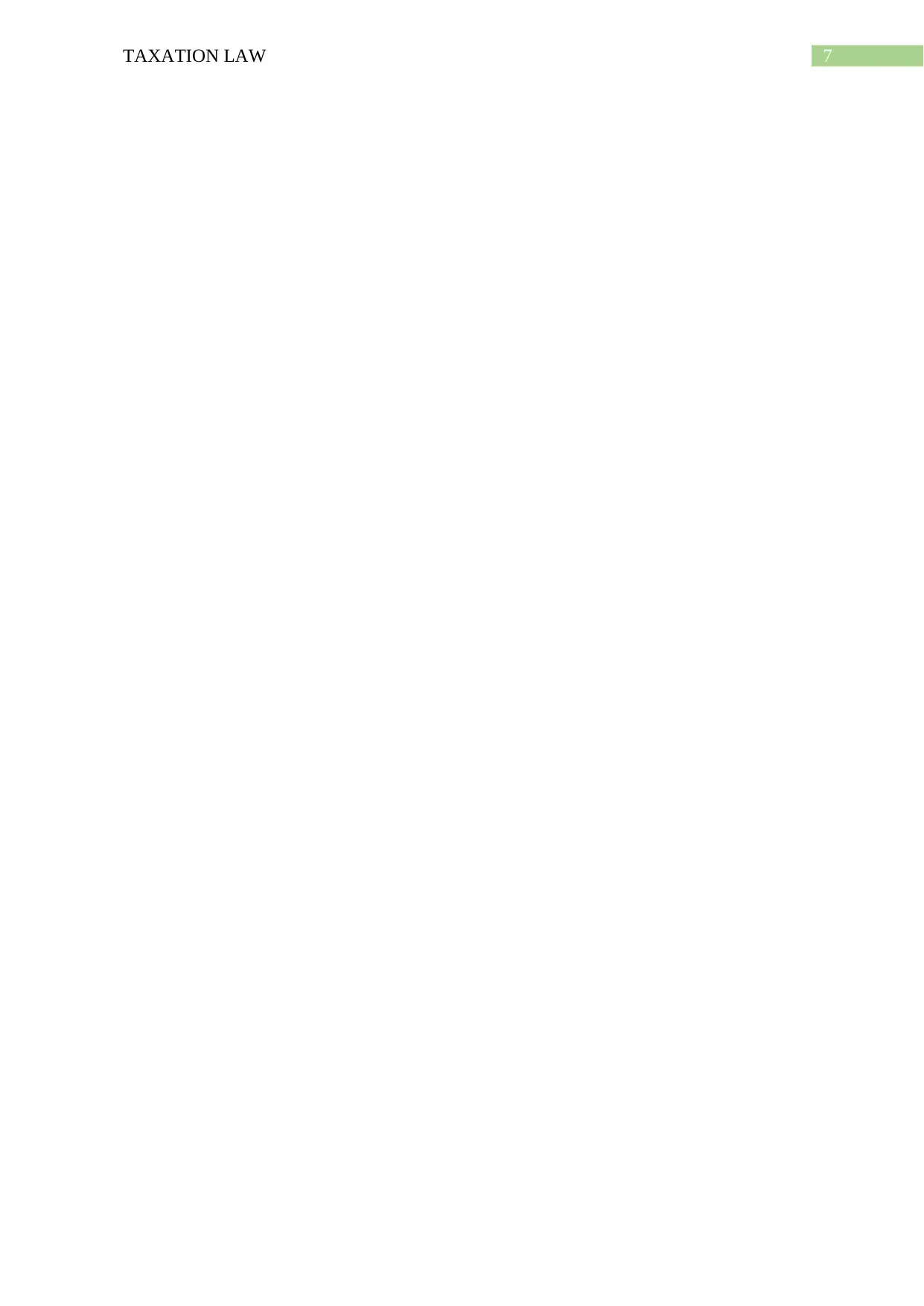
7TAXATION LAW
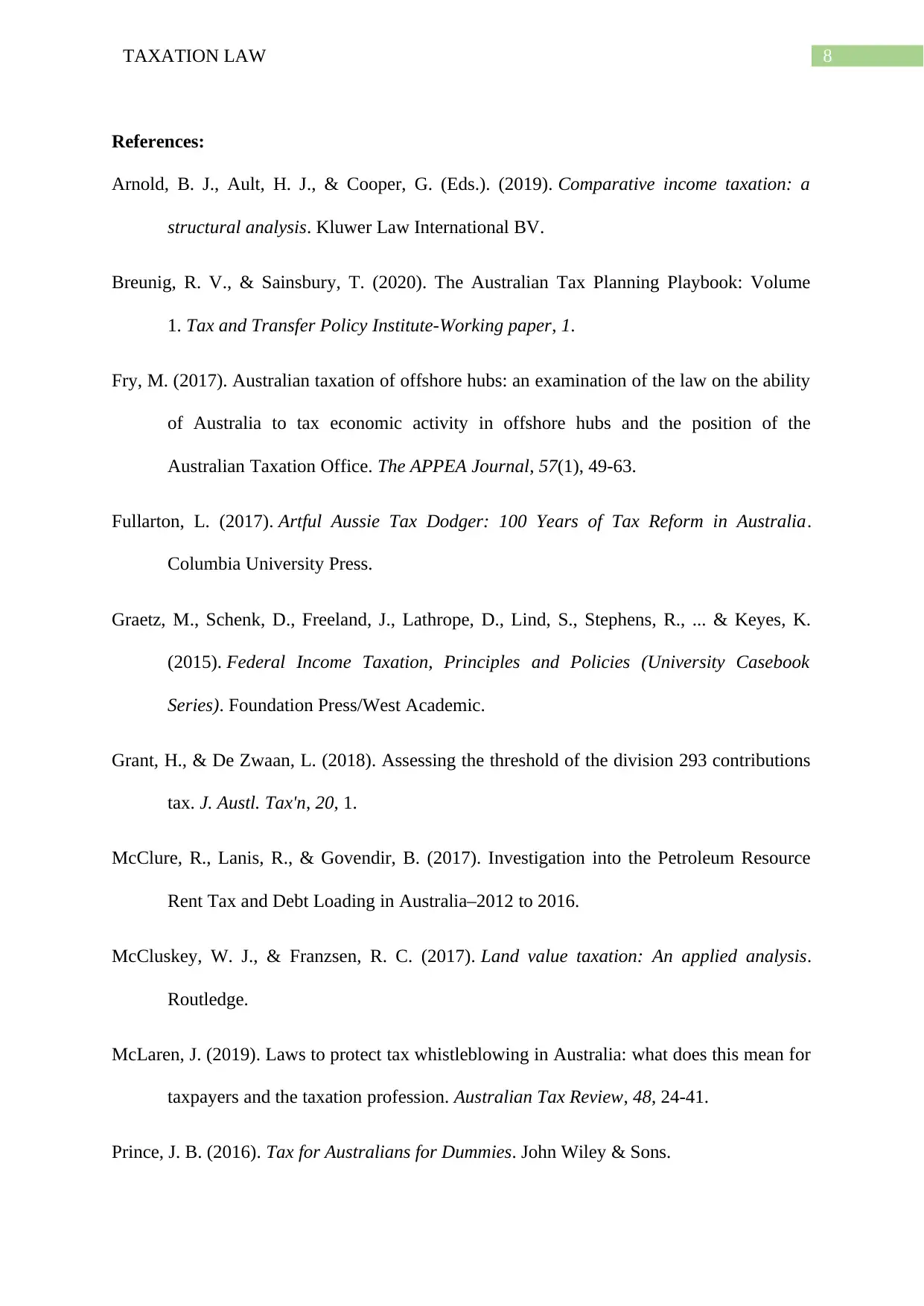
8TAXATION LAW
References:
Arnold, B. J., Ault, H. J., & Cooper, G. (Eds.). (2019). Comparative income taxation: a
structural analysis. Kluwer Law International BV.
Breunig, R. V., & Sainsbury, T. (2020). The Australian Tax Planning Playbook: Volume
1. Tax and Transfer Policy Institute-Working paper, 1.
Fry, M. (2017). Australian taxation of offshore hubs: an examination of the law on the ability
of Australia to tax economic activity in offshore hubs and the position of the
Australian Taxation Office. The APPEA Journal, 57(1), 49-63.
Fullarton, L. (2017). Artful Aussie Tax Dodger: 100 Years of Tax Reform in Australia.
Columbia University Press.
Graetz, M., Schenk, D., Freeland, J., Lathrope, D., Lind, S., Stephens, R., ... & Keyes, K.
(2015). Federal Income Taxation, Principles and Policies (University Casebook
Series). Foundation Press/West Academic.
Grant, H., & De Zwaan, L. (2018). Assessing the threshold of the division 293 contributions
tax. J. Austl. Tax'n, 20, 1.
McClure, R., Lanis, R., & Govendir, B. (2017). Investigation into the Petroleum Resource
Rent Tax and Debt Loading in Australia–2012 to 2016.
McCluskey, W. J., & Franzsen, R. C. (2017). Land value taxation: An applied analysis.
Routledge.
McLaren, J. (2019). Laws to protect tax whistleblowing in Australia: what does this mean for
taxpayers and the taxation profession. Australian Tax Review, 48, 24-41.
Prince, J. B. (2016). Tax for Australians for Dummies. John Wiley & Sons.
References:
Arnold, B. J., Ault, H. J., & Cooper, G. (Eds.). (2019). Comparative income taxation: a
structural analysis. Kluwer Law International BV.
Breunig, R. V., & Sainsbury, T. (2020). The Australian Tax Planning Playbook: Volume
1. Tax and Transfer Policy Institute-Working paper, 1.
Fry, M. (2017). Australian taxation of offshore hubs: an examination of the law on the ability
of Australia to tax economic activity in offshore hubs and the position of the
Australian Taxation Office. The APPEA Journal, 57(1), 49-63.
Fullarton, L. (2017). Artful Aussie Tax Dodger: 100 Years of Tax Reform in Australia.
Columbia University Press.
Graetz, M., Schenk, D., Freeland, J., Lathrope, D., Lind, S., Stephens, R., ... & Keyes, K.
(2015). Federal Income Taxation, Principles and Policies (University Casebook
Series). Foundation Press/West Academic.
Grant, H., & De Zwaan, L. (2018). Assessing the threshold of the division 293 contributions
tax. J. Austl. Tax'n, 20, 1.
McClure, R., Lanis, R., & Govendir, B. (2017). Investigation into the Petroleum Resource
Rent Tax and Debt Loading in Australia–2012 to 2016.
McCluskey, W. J., & Franzsen, R. C. (2017). Land value taxation: An applied analysis.
Routledge.
McLaren, J. (2019). Laws to protect tax whistleblowing in Australia: what does this mean for
taxpayers and the taxation profession. Australian Tax Review, 48, 24-41.
Prince, J. B. (2016). Tax for Australians for Dummies. John Wiley & Sons.
⊘ This is a preview!⊘
Do you want full access?
Subscribe today to unlock all pages.

Trusted by 1+ million students worldwide
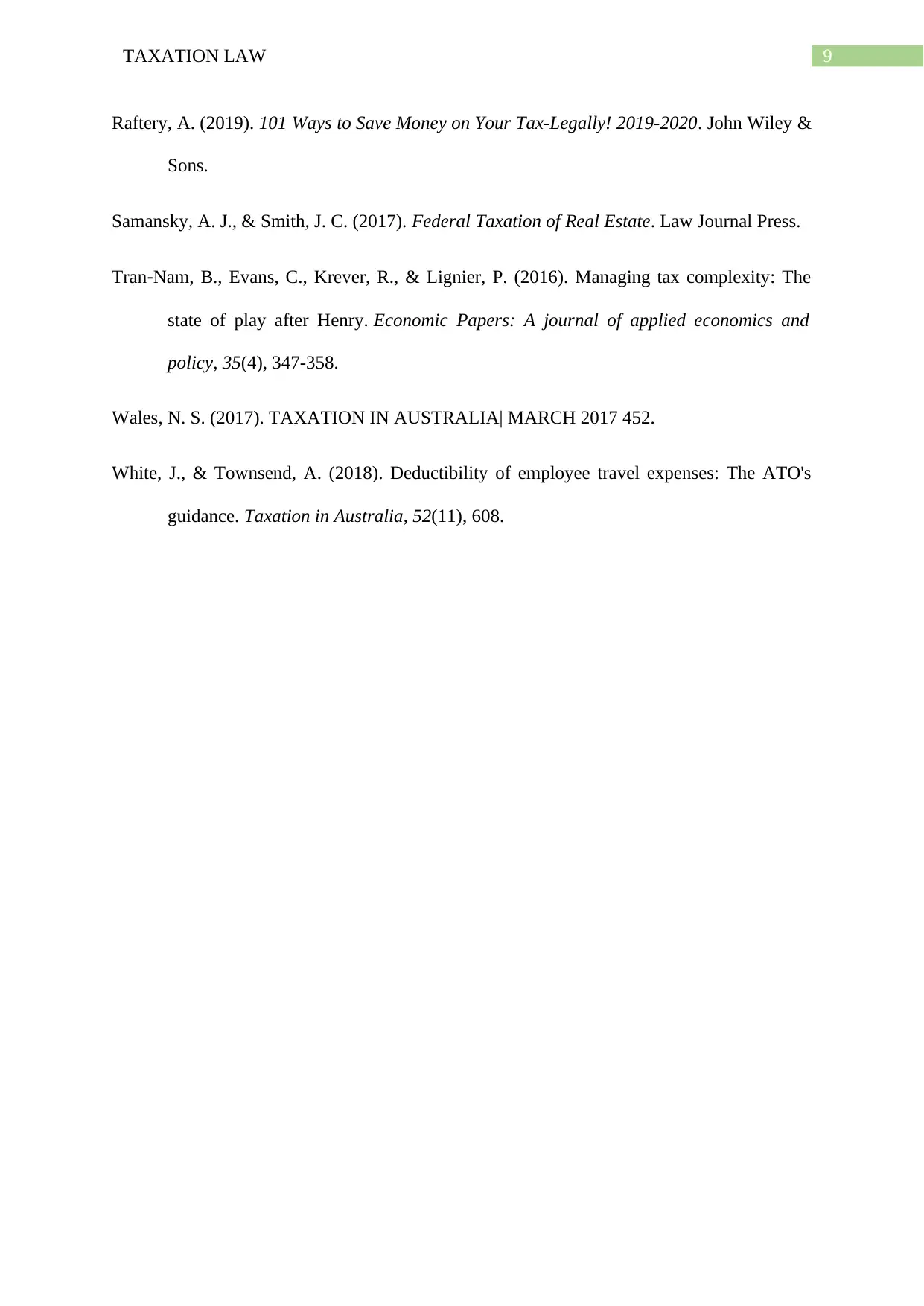
9TAXATION LAW
Raftery, A. (2019). 101 Ways to Save Money on Your Tax-Legally! 2019-2020. John Wiley &
Sons.
Samansky, A. J., & Smith, J. C. (2017). Federal Taxation of Real Estate. Law Journal Press.
Tran‐Nam, B., Evans, C., Krever, R., & Lignier, P. (2016). Managing tax complexity: The
state of play after Henry. Economic Papers: A journal of applied economics and
policy, 35(4), 347-358.
Wales, N. S. (2017). TAXATION IN AUSTRALIA| MARCH 2017 452.
White, J., & Townsend, A. (2018). Deductibility of employee travel expenses: The ATO's
guidance. Taxation in Australia, 52(11), 608.
Raftery, A. (2019). 101 Ways to Save Money on Your Tax-Legally! 2019-2020. John Wiley &
Sons.
Samansky, A. J., & Smith, J. C. (2017). Federal Taxation of Real Estate. Law Journal Press.
Tran‐Nam, B., Evans, C., Krever, R., & Lignier, P. (2016). Managing tax complexity: The
state of play after Henry. Economic Papers: A journal of applied economics and
policy, 35(4), 347-358.
Wales, N. S. (2017). TAXATION IN AUSTRALIA| MARCH 2017 452.
White, J., & Townsend, A. (2018). Deductibility of employee travel expenses: The ATO's
guidance. Taxation in Australia, 52(11), 608.
1 out of 10
Related Documents
Your All-in-One AI-Powered Toolkit for Academic Success.
+13062052269
info@desklib.com
Available 24*7 on WhatsApp / Email
![[object Object]](/_next/static/media/star-bottom.7253800d.svg)
Unlock your academic potential
Copyright © 2020–2025 A2Z Services. All Rights Reserved. Developed and managed by ZUCOL.





